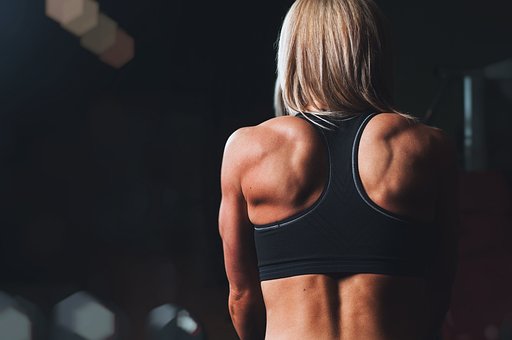Massage for Athletes and Sports Injuries
By Ashley Zimmermann

by Scott Webb from Pixabay
*Disclaimer* As always, consult your licensed massage therapist or physician for medical advice. This article is not intended to treat, diagnose, or provide medical advice.
Many recreational and professional athletes know the importance of receiving treatment from a physical therapist, chiropractor, or physician if they experience an injury. But did you know that a sports massage can also be a good option for an injury? Massage therapists specialize in treating the body's soft tissues, like muscles, connective tissues, and fascia; these tissues can often experience trauma during an injury. Alternatively, massage can be a beneficial 'maintenance' treatment for athletes to use on a regular basis, as one might do with chiropractic appointments.
For Runners
Different athletic spheres (and different individual athletes) definitely have different opinions surrounding the efficacy of massage. One contributor to Runner's World isn't initially thrilled about the idea of massage for runners:
"The researchers concluded that, in the short term, sports massage doesn't improve measures of performance (sprint, jump, strength, and performance). They also concluded that sports massage doesn't reduce muscle fatigue."
However, their article goes on to explain that massage therapy for runners can be understood in the same terms as getting enough sleep, stretching, and eating a healthy diet, as a health maintenance component. Another Runner's World article praises sports massage pre- and post-event. Track-and-field athlete Obsa Ali and Olympian Diane Nukuri incorporate massage therapy into their regular training, and both mention that massage aids in preventing injuries and developing performance.
For Bodybuilders
Massage therapy has long been lauded in the bodybuilding world. Lisa Sutton of Bodybuilding.com says massage should not be considered a luxury as a bodybuilder, rather "it should be regarded as part and parcel of your dedication to living a healthy life. Research establishes that regular massage therapy improves range of motion, reduces recovery time, increases muscle tone, and increases flexibility."
This attitude makes sense. Bodybuilding is all about muscle development. These athletes are also acutely aware of their "mind-muscle connection," which no doubt contributes to their appreciation of massage. Justin Compton, an IFBB Pro Bodybuilder, told Muscular Development, "As bodybuilders, we can't afford to function any less than 100 percent, so it is a 'must' to keep yourself in check ... Having the muscles function at their full capacity is very crucial to growth as well as injury prevention. Deep tissue [massage] is great to implement to remove any scar tissue or adhesions that our bodies may have. With constant strain and tension on your muscles, along with the lack of stretching, it is highly likely that you will build up very small adhesions in the muscle."
For CrossFitters
CrossFitters are a tough breed of athlete. NBC News tells us that CrossFit has an emphasis on developing powerful performance. "CrossFit is a strength and conditioning workout that is made up of functional movement performed at a high-intensity level." Participants are often throwing, squatting, and lifting many pounds at a quick pace. A "workout of the day" (WOD) might include use of "kettlebells, rowers and bikes, medicine balls, speed ropes, rings, and plyo boxes." Perhaps all of the above.
High-intensity sport spread over several domains can come with a price. NBC interviewed physical therapist Cuyler Hudson, who said, "The injury rate of CrossFit is about 20 percent, meaning 20 percent of people who perform CrossFit branded workouts regularly will be injured at some point, which is high for a recreational activity." He elaborates that form can deteriorate when you become fatigued. If you're moving heavy weight at a fast pace, injury could be (and often is) right around the corner.
But this is the essence of CrossFit, so CrossFitters are unlikely to take several weeks or months of recovery time, whether or not it is recommended. So WODbody Sports Massage created their "corrective bodywork" treatment, designed for CrossFitters. MASSAGE Magazine interviewed Vincent Bounds of WODbody, who explained: "We're basically taking people off the table and putting them right back into action. They don't have time for rest. We're stimulating their tissues and trying to correct their tissues."
Deep Tissue, Swedish, or Otherwise?
Runner's World interviewed Julia Iafrate, D.O., a sports medicine doctor and professor, who described sports massage in the following way: "I define a sports massage as manual manipulations of muscle and soft tissue by a qualified professional with the purpose of improving performance in or recovery of sport."
As mentioned above, Vincent Bounds and Stacey Meek of WODbody call their treatment technique "corrective bodywork." As a non-therapist, I don't understand technique specifics, but I can imagine corrective bodywork would likely not be similar to a 'spa-style' or Swedish technique.
Bodybuilder Justin Compton prefers deep-tissue work and ART [active release techniques]. He says, "ART is great for tendonitis and other miscellaneous pains, along with improving mobility."
From my own personal experience, I prefer deep-tissue work over other techniques since I tend to develop stubborn adhesions from the combination of a desk job and amateur weight training. The spa-style relaxation massage feels nice but doesn't address my root physical concerns.
When and How Often?
Like getting a regular, [non-sport] massage, this is a personal decision dependent on lots of factors. Are you prepping for a major sports event? Have you experienced a recent or chronic injury? Are you a pro athlete or an amateur? What do your budget and schedule allow for? Talk through these specifics with your massage therapist, coach, and medical care team. The U.K. National Sports Medicine Institute (NSMI) instructs that sports massage should be avoided "if the athlete is suffering from an illness or infection or has been diagnosed with a serious health condition such as cancer or hemophilia."
The consensus among athletes and experts in the running, bodybuilding, and CrossFit communities is that sports massage is valuable for maintaining a healthy, athletics-focused lifestyle. Sports massage can be part of a treatment plan for an acute injury or long-term 'maintenance' care.
Massage for Sports Injury
I'll leave it to the experts to discuss the benefits of massage for sports injuries. The article "Effectiveness and safety of massage for athletic injuries," published in Medicine journal, eloquently summarizes below:
"Implemented on people's skin, muscles, and joints as an important part of complementary and alternative medicine (CAM), massage therapy has a positive effect on athletic injuries. . . . Massage therapy, one of the most effective and widely used CAM, is also one of the most common techniques used by athletes to recover and enhance their athletic performance after exercise. Under the operation of well-trained professionals, massage is considered to be a safe and effective treatment without any significant risks or side effects. At present, scientific and technological research in this field is developing rapidly. Studies have shown that the benefits of massage therapy include reduced post-exercise pain and perceived fatigue, attenuated inflammatory signals of exercise-induced muscle injury, improved muscle strength and self-perception of exercise-induced muscle injury, restoration of heart rate variability and diastolic blood pressure, acute relief of muscle soreness after exercise, reduced muscle tension, post-exercise serum creatine kinase, swelling and respiratory pattern disorders, which help to prevent injuries. . . . Compared with other therapies, massage therapy has the advantages of non-invasive and relatively low cost. Therefore, it is necessary to pay attention to the research and development in this field."
References:
http://www.nsmi.org.uk/articles/sports-massage/index.html - Sports Massage
https://www.runnersworld.com/health-injuries/a32792134/sports-massage-for-runners/ - What Sports Massage Can and Can't Do
https://runnersworldonline.com.au/everything-youve-ever-wanted-know-sports-massage/- Everything You've Ever Wanted to Know About Sports Massage
https://www.nbcnews.com/better/lifestyle/what-crossfit-it-right-you-here-s-what-you-need-ncna1070886 - What is CrossFit? And is it right for you? Here's what you need to know
https://www.massagemag.com/crossfit-massage-88619/ - HOW CROSSFIT MASSAGE GREW THIS PRACTICE FROM TWO TO SEVEN MTS
https://www.bodybuilding.com/fun/lisa10.htm - The Benefits Of Massage Therapy
https://www.musculardevelopment.com/training/14879-deep-tissue-massage-for-bodybuilders-4-top-pros-have-their-say.html#.Y2g5QXbMLoQ- DEEP TISSUE MASSAGE - IS IT USEFUL FOR BODYBUILDERS?
https://www.ncbi.nlm.nih.gov/pmc/articles/PMC8360410/ - Guo G, Xie S, Cai F, Zhou X, Xu J, Wu B, Wu G, Xiao R, Xu X, Lu P, Fang M. Effectiveness and safety of massage for athletic injuries: A protocol for systematic review and meta-analysis. Medicine. 2021;100:32(e26925).
<<-- Back to Blogs Email to a friend



 Picturesque Massage
Picturesque Massage